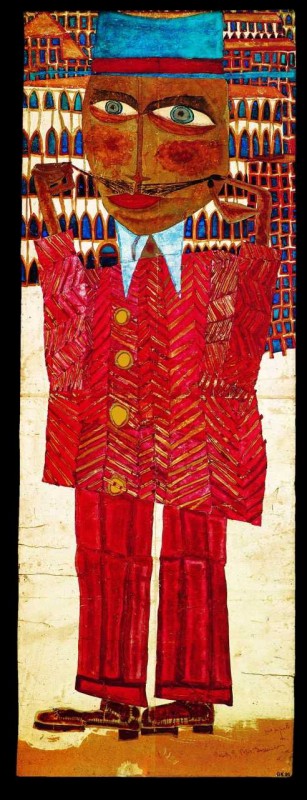131
EUROPÄER DER SICH SEINEN SCHNURBART HÄLT
EUROPEAN TWIRLING HIS MOUSTACHE
EUROPEEN QUI TIENT SA MOUSTACHE
1951
Painted in Aflenz, Bürgeralm, September 1951
in the company of his mother
in the company of his mother
1280 mm x 460 mm
Watercolour on wrapping paper, primed with chalk, zinc white and fish glue
- Art-Club, Vienna, 1952
- Art-Club, Vienna, 1953
- Galleria del Naviglio, Milan, 1955
- 31st Venice Biennial, 1962
- Galleria La Medusa, Rome, 1962
- Travelling exhibition 1968/69:
- University Art Museum Berkeley, 1968
- Santa Barbara Museum of Art, 1968/69
- The Museum of Fine Arts, Houston, 1969
- The Arts Club of Chicago, 1969
- The Galerie St. Etienne, New York, 1969
- *
- Aberbach Fine Art, New York, 1973
- Art-Club, Vienna, 1951
- Peggy Guggenheim Collection, Venice, 1954/55
- W. Schmied, Hundertwasser, Feldafing, 1964 and ed. 1973, pp. 43 (c), 45
- W. Schmied, Hundertwasser, Salzburg 1974, pl. 20 (c), p. 311
- P. Restany, Hundertwasser, New York, 1978, p. 51 (c)
- J. F. Mathey, Hundertwasser, Munich, 1985 and ed. 1992, p. 17 (c)
- Das Hundertwasser Haus, Vienna, 1985, p. 11 (c)
- R. Koyanagi (ed.), Mujinkan 1 - Hundertwasser, Tokyo, 1988, pp. 18 (c), 70
- P. Restany, Die Macht der Kunst, Hundertwasser - Der Maler-König mit den fünf Häuten, Cologne, 1998, p. 36 (c) and ed. 2018, p. 34 (c)
- W. Schmied, Hundertwasser 1928-2000, Catalogue Raisonné, Cologne, 2000, Vol. I, pp. 9 (c), 11, 58/59, 165, 206
- Hundertwasser Portfolio, Cologne, 2001, inside (c, b) and back cover (c)
- A. C. Fürst, Hundertwasser 1928-2000, Catalogue Raisonné, Cologne, 2002, Vol. II, pp. 222-224 (and c)
- F. Hundertwasser / P. Restany, Hundertwasser, New York, 2008, p. 15 (c)
- Briefmarkenbuch, Hundertwasser in Wien, Vienna, 2011, p. 13 (c)
- G. Illetschko, Planet Hundertwasser, Munich, 2012, p. 34 (c)
- Leaflet: Art Club, Vienna, 1952, cat. 2
- Leaflet: Art Club, Vienna, 1953, cat. 7
- XXXI. Biennale di Venezia, Austria, 1962, cat. 1
- Kestner-Gesellschaft, Hanover, 1964, p. 112, p. 155 (c)
- University Art Museum, Berkeley, 1968, p. 39 (c), cat. 13
- Aberbach Fine Art, New York, 1973, p. 9 (c), cover (c)
- Musée des Beaux-Arts et de la Dentelle, Alençon, 2001, p. 10 (c)
- HW-Die Kunst des grünen Weges, KunstHausWien, Vienna, 2011, pp. 36 (c), 213
- W. Schmied (ed.), Geschichte der bildenden Kunst in Österreich - 20. Jh., Munich, 2002, p. 118 (b)
- Weltpresse, Feb. 1952, Vienna (b)
- Wiener Illustrierte, April 1954, Vienna (b)
- Wiener Samstag, April 1954, Vienna (b)
- Das Kunstwerk, no. 5, Baden-Baden, 1956, p. 43 (b)
- L'Oeil, Feb. 1961, Paris, p. 47 (b)
- Die Zukunft, no. 6, March 1965, Vienna, p. 27 (b)
- What's on, Stockholm, Jan. 1965 (b)
- Art, no. 11, Nov. 1983, Hamburg, p. 23 (c)
- Watercolor, no. 14, n.p., 2000, p. 22 (c)
- Postcard, Vienna, 1951 (b)
- Postcard Edizioni del Cavallino, Venice, 1964 (together with 445)
- Postcard Edizioni del Cavallino, Venice, 1968 (together with 216)
- Invitation card, Aberbach Fine Arts, New York, 1973, 20.7 x 7.3 cm, gothic windows and coat buttons in various metal imprints
- Exhibition poster, Aberbach Fine Arts, New York, 1973, with various metal imprints, 30.7 x 86.7 cm
- Calendar 1976, Verlag Galerie Welz, Salzburg (September)
- Postcard calendar 1977, cicero, Stuttgart (March)
- Art Print "European", Gruener Janura AG, Glarus, 1984 (8 colour offsetprint with metal imprints in 2 colours, 98 x 34 cm)
- Hundertwasser Pullover, Gianni Bugli, Milan 1996 (limited ed. of 999)
- Postcard, Buchheim Verlag, Feldafing, n.d. (together with 216, repr.)
- Hundertwasser 2004 Calendar, Taschen, Cologne (and reprints)
- Hundertwasser 2012 Calendar, Taschen, Cologne (and reprints)
- Hundertwasser Vertical Wall Calendar Art 2013, Wörner, Rutesheim (cover, detail)

Hundertwasser's comment on the work
At the beginning of my career I was still under Klee's influence. I had just returned from Africa. At the time the blue of African houses interested me very much. I put that in the hat. At the time I was painting very much after nature. The painting is a homage to Africa and Europe. There are Gothic windows - and just the same the colours are oriental. In the title the German word Schnurrbart (moustache) is intentionally spelled with only one "r": Schnurbart. (from: Hundertwasser, Buchheim Verlag, Feldafing, 1964, p. 42)
One can't imagine it today, but this painting unleashed the first "Hundertwasser scandal", with the press feeding the flames, as could be expected, because the title said Schnurbart instead of Schnurrbart, because the painting was framed with old Venetian-blind slats full of "bedbug holes", because of its naive mannerism. It seemed incredible that somebody who had attended the Academy intentionally painted like a child. That was during my first exhibition at the Vienna Art Club in 1952. I wanted somehow to express my commitment to being a European and to the tradition of our culture. I also began to make a point of writing with pen and ink in the old German script.
Paintings often have sad stories to tell. Especially this one. I sold it to Peggy Guggenheim for 100 dollars, assuming it would become a part of the Guggenheim Collection in Venice. Years later, when I wanted to exhibit the painting, Peggy told me she had given it to her daughter Peggeen because her grandchild (while still a baby) loved it so much that he played with the watercolour and tore it to pieces. I fetched the scraps of paper, had the painting restored and framed at my expense and gave it back to Peggy, again in the hope that it would be put in her collection. But a few years later Peggeen sold the "European" to the collector Aberbach in New York for 7,000 dollars. Later she committed suicide in Paris. (from: Hundertwasser 1928-2000, Catalogue Raisonné, Vol. 2, Taschen, Cologne, 2002, pp. 222-223)